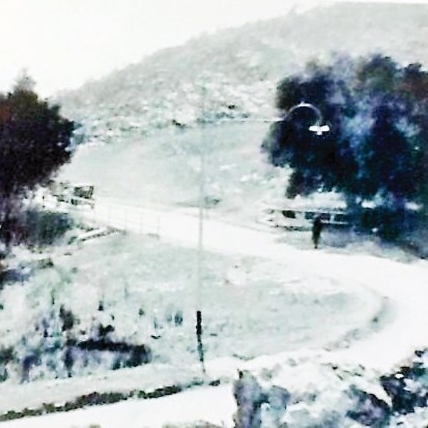click to dowload our latest edition
CLICK HERE TO SUBSCRIBE TO OUR NEWSLETTER


Published
3 years agoon
By
Jordan MosheThe breathtaking views of Linksfield Ridge in Johannesburg might never have become accessible were it not for Dr Hermann Kallenbach, a renowned architect and close friend of Mahatma Gandhi.
Last Sunday, 8 November, representatives of the Lithuanian embassy and the Johannesburg Heritage Foundation (JHF) trekked along the ridge, visiting sites of architectural and historical importance in Kallenbach’s life.
Kallenbach spent much of his professional life in Johannesburg where he left his mark, introducing numerous elaborate terraces, stairways, retaining walls, and stone garden tables on Linksfield Ridge. In greater Johannesburg, Kallenbach is known for some well-regarded religious, commercial, and residential buildings, ranging from the Greek Orthodox Church in Joubert Park to the Lewis & Marks Building and Arop House in downtown Johannesburg.
His Linksfield legacy began in the 1930s, when Kallenbach (who arrived from Germany in 1896) and his architect partner, AM Kennedy, bought up portions of land in “the township of Linksfield” which had been formally approved in 1922.
The portions would be merged into a single suburb, and in 1939, Kallenbach would become the owner of the ridge itself. Under his watch, the eponymously named Kallenbach Drive was laid down, and vast tracts of undeveloped land in Linksfield were given to the city council for the construction of Sylvia Pass.
Sunday’s tour was part of a Lithuanian embassy initiative to learn more about prominent Lithuanians who came to South Africa.
“Since we opened the embassy in 2015, it’s been important to us to learn more about the prominent Lithuanians who came to South Africa, Jewish Litvaks who contributed to South Africa in different ways,” Inga Stankaite, the chargé d’affaires at the embassy in Pretoria, told the SA Jewish Report.
“Kallenbach was actually born in the very small town of Rusne in Lithuania, and while much is known about him in relation to his connection with Gandhi, we wanted to do more to celebrate him in his own right.”
Last year, the Lithuanian government declared 2020 as the year of the Vilna Gaon and Lithuanian Jewish history, making the celebration of Kallenbach’s legacy especially appropriate. In August, the Lithuanian embassy reached out to JHF Chairperson Kathy Munro to devise ways to pay tribute to Kallenbach.
“The year 2021 is actually the 150 year anniversary of Kallenbach’s birth. His friendship with Gandhi has been celebrated in Rusne every year since a statue of the them was erected in 2016,” says Stankaite.
“We wanted more research into his personality, and to recognise his contribution to Johannesburg in time for the anniversary.”
The embassy also decided to commission two blue plaques (markers installed by the JHF across Johannesburg to mark the heritage of various sites) at sites in Linksfield in recognition of Kallenbach’s impact.
The JHF’s Munro undertook the project along with Israeli multidisciplinary writer and researcher, Shimon Lev. She also led the Linksfield tour on Sunday.
Kallenbach was an unusual figure, says Munro. “He was part of group of largely Jewish and white people who supported Gandhi, verging towards socialism because they wanted to create a better world for all.”
Kallenbach even established a rural, co-operative, pre-industrial community at Tolstoy Farm at Lawley to the south-west of Johannesburg, where people grew their own food, made their own sandals, and became skilled carpenters and bricklayers according to Tolstoyan ideals. Munro maintains that this project influenced Gandhi’s later creation of ashrams in India, and could be a strand in the shaping of the kibbutz in Israel.
The tour included sites featuring Kallenbach’s work across the ridge, including New Mountain Road, the iconic Kallenbach Drive, Grove Road, and Mountain View, as well as Satyagraha House, which Kallenbach shared with Gandhi.
Says Munro, “The original house was called ‘The Kraal’ and was designed and built by Kallenbach, which he came to live in with Gandhi. Today, it’s a guest house and museum which captures the spirit of these men, and is an example of a successful conservation of heritage.
It included stops at the properties of Gerald Gordon, a major contributor to architectural innovation, who appreciated Kallenbach’s work and bought a share of the icon’s estate for the construction of his home.
“Gordon had a social conscience,” said Munro. “He worked at the point where architecture, new technology, and good design could meet to serve housing needs in South Africa.”
Along with Kallenbach’s plaque, there are discussions afoot for the installation of a plaque on New Mountain Road to celebrate Gordon’s architectural legacy.
Munro, who is also a visiting professor in the school of architecture and planning at the University of the Witwatersrand, welcomed the Lithuanian embassy’s commitment to furthering Kallenbach’s legacy.
Kallenbach’s work gives a sense of identity to the city, but sadly, many of his buildings have been demolished. We cannot save everything that is older than 60 years, but we do want to have people pause and ask what mattered in the city 100 years ago, and how we can tie it to the life of today.
